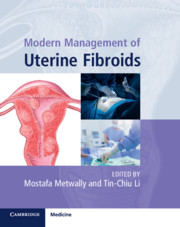Book contents
- Modern Management of Uterine Fibroids
- Modern Management of Uterine Fibroids
- Copyright page
- Contents
- Contributors
- Foreword
- Chapter 1 Pathophysiology of Uterine Fibroids
- Chapter 2 Evaluation of Uterine Fibroids Using Two-Dimensional and Three-Dimensional Ultrasonography
- Chapter 3 Ulipristal and Other Medical Interventions for Treatment of Uterine Fibroids
- Chapter 4 The Role of Magnetic Resonance Imaging in the Management of Fibroids
- Chapter 5 Fibroids and Fertility
- Chapter 6 Fibroids and Reproduction
- Chapter 7 Open Myomectomy
- Chapter 8 Laparoscopic and Robotic Myomectomy
- Chapter 9 Principles and Technique of Laparoscopic Myomectomy
- Chapter 10 Uterine Fibroids
- Chapter 11 Total Laparoscopic Hysterectomy for the Fibroid Uterus
- Chapter 12 Hysteroscopic Resection of Submucosal Fibroids
- Chapter 13 Modern Management of Intramural Myomas
- Chapter 14 Outpatient Myomectomy
- Chapter 15 Vaginal Hysterectomy with Fibroids
- Chapter 16 Leiomyosarcoma
- Chapter 17 MRI-Guided Ultrasound Lysis of Fibroids
- Chapter 18 Embolization for the Management of Uterine Fibroids
- Chapter 19 Uterine Fibroids in Postmenopausal Women
- Appendix: Video Captions
- Index
- References
Chapter 11 - Total Laparoscopic Hysterectomy for the Fibroid Uterus
Published online by Cambridge University Press: 10 October 2020
- Modern Management of Uterine Fibroids
- Modern Management of Uterine Fibroids
- Copyright page
- Contents
- Contributors
- Foreword
- Chapter 1 Pathophysiology of Uterine Fibroids
- Chapter 2 Evaluation of Uterine Fibroids Using Two-Dimensional and Three-Dimensional Ultrasonography
- Chapter 3 Ulipristal and Other Medical Interventions for Treatment of Uterine Fibroids
- Chapter 4 The Role of Magnetic Resonance Imaging in the Management of Fibroids
- Chapter 5 Fibroids and Fertility
- Chapter 6 Fibroids and Reproduction
- Chapter 7 Open Myomectomy
- Chapter 8 Laparoscopic and Robotic Myomectomy
- Chapter 9 Principles and Technique of Laparoscopic Myomectomy
- Chapter 10 Uterine Fibroids
- Chapter 11 Total Laparoscopic Hysterectomy for the Fibroid Uterus
- Chapter 12 Hysteroscopic Resection of Submucosal Fibroids
- Chapter 13 Modern Management of Intramural Myomas
- Chapter 14 Outpatient Myomectomy
- Chapter 15 Vaginal Hysterectomy with Fibroids
- Chapter 16 Leiomyosarcoma
- Chapter 17 MRI-Guided Ultrasound Lysis of Fibroids
- Chapter 18 Embolization for the Management of Uterine Fibroids
- Chapter 19 Uterine Fibroids in Postmenopausal Women
- Appendix: Video Captions
- Index
- References
Summary
Hysterectomy is one of the most common major gynaecological procedures and has been reported in early Greek manuscripts as early as 50 BC and AD 120, though proof that it was performed is limited. However, it was not until the 1800s that the first planned vaginal hysterectomy was recorded [1]. Traditionally, hysterectomy is done either by an open abdominal approach via a midline or transverse incision, or by a vaginal approach. The first laparoscopic hysterectomy was described by Harry Reich and colleagues in 1989 [2]. With advances in technology, development of new instruments and standardization of surgical techniques, the laparoscopic approach has fast gained popularity across gynaecological practice and has become an independent alternative treatment option [3–6].
- Type
- Chapter
- Information
- Modern Management of Uterine Fibroids , pp. 99 - 103Publisher: Cambridge University PressPrint publication year: 2020



